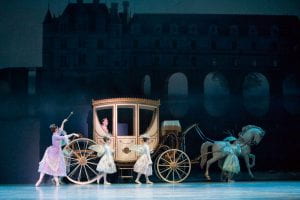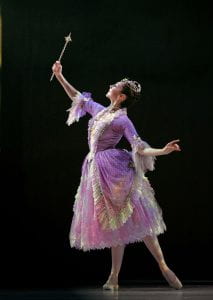It’s hard to top Pacific Northwest Ballet’s production of Kent Stowell’s Cinderella (Jan 31-Feb 9, 2020) at Seattle’s McCaw Hall. The company premiered it almost 26 years ago—I was there then, and I can remember being impressed with both design and concept, as well as the mesmerizing Prokofiev music. This year, I was fortunate to see three different lead casts—Noelani Pantastico and Seth Orza, Leta Biasucci and Lucien Postlewaite, and Angelica Generosa and newly-promoted Kyle Davis.

Seeing Pantastico perform was a particular delight as I recall her as a young Cinderella, having just been tapped—if not pulled, by Stowell, from the corps—to perform the lead role.
She was a little tentative then, but nonetheless, striking. To see Pantastico as a more mature performer was truly a pleasure. At the premiere, she was joyous, ebullient, daring—her exact arm gestures, remarkable. The Cinderella role demands great focus and musicality, and Biasucci and Generosa beautifully delivered. Biasucci was confident and precise, even her torso was utterly expressive, and she is a masterful jumper. Generosa was an especially inviting Cinderella, and offered some of the most meticulous attitude turns. Her control was impressive.
All the lead men shined in both dance and personality—Orza, spry, noble, but accessible; Postlewaite, charming and skillful, the heart and soul of the dance; and Davis, a singularly strong actor (and a knock-out as the fierce, energetic Evil Sprite opening night). Each of the three princes gave bravura performances.
Notable jesters included rock-solid technician Benjamin Griffiths and the impulsive-but-effective Kyle Davis. Davis is a spectacular turner and boasted some of the more memorable interactions (with, say, the silly stepsisters).
My favorite stepmother and stepsisters casting was Cecilia Iliesiu, and Amanda Morgan and Juliet Prine, respectively. Iliesiu and Morgan easily provided the most entertaining and compelling dance moves. Iliesiu, especially, is a scene stealer—virtually stalking her prey.
I have several notes for the seasonal fairies. Generosa was quick and poised, and Madison Rayn Abeo, lively and engaged as the “spring” fairy. Both Elizabeth Murphy and Sarah Ricard Orza were masters of the slow, expansive moments required of the “summer” fairy. Of note was Margaret Mullin’s singular dramatic flair as the “fall” fairy. Leah Merchant and Cecilia Iliesiu conveyed urgency, as well as finesse as the “winter” fairy.
Kudos, too, to all the “bugs”—all quite promising dancers. Memorable, also, were the Memory Mother, Laura Tisserand (who confidently dances, too, the godmother role, with some of the most pristine turns in the performance), and Memory Father Joshua Grant.


Acclaim, too, for Elle Macy and her big, expressive gestures.
The dancing is spectacular, but it’s the music of the PNB Orchestra, conducted by Emil de Cou, that dominates. At times, the dance was perfectly matched with the music, as in the opening of Act II, in Tchaikovsky’s Mephisto Walt—performed by PNB’s ensemble dancers in a blaze of red costumes. Additional satisfying matches could be seen in the rising tension in the first encounter between Cinderella and her prince, and then in their tender pas de deux shortly after.
This is difficult music to perform with Prokofiev’s strange tempos and harmonies—and many exposed openings and variations that provide plenty of surprises (for one, it features a lot of brass). The emotive score is driving, ominous, menacing. It is brilliant in its foreshadowing. Such is the genius of Prokofiev—favoring theatrical variety over narrative—and, coupled with the PNB dancing, producing some of the most memorable performances this season.
its really creative i think it will be great performance